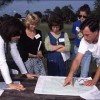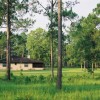 A result of the influx of new residents to the South is an expansion of urban areas into forests and other natural areas, creating areas referred to as the wildland-urban interface. Interface issues of most concern vary from state to state, but some key issues are consistent across the South. the US Forest Service conducted a series of focus groups in 2000. Key issues gleaned from those focus groups and other related sources are described in this 5-page fact sheet written by L. Annie Hermansen-Baez, Jennifer Seitz, and Martha C. Monroe, and published by the UF Department of School of Forest Resources and Conservation, February 2013.
A result of the influx of new residents to the South is an expansion of urban areas into forests and other natural areas, creating areas referred to as the wildland-urban interface. Interface issues of most concern vary from state to state, but some key issues are consistent across the South. the US Forest Service conducted a series of focus groups in 2000. Key issues gleaned from those focus groups and other related sources are described in this 5-page fact sheet written by L. Annie Hermansen-Baez, Jennifer Seitz, and Martha C. Monroe, and published by the UF Department of School of Forest Resources and Conservation, February 2013.
http://edis.ifas.ufl.edu/fr264
Tag: Wildland-Urban Interface
Forest Management in the Interface: Reducing Fire Risk (FOR179/FR249)
 Wildfire is one of the most serious and publicized challenges facing interface forest management. Wildfires can change forest vegetation, affect human health, and cause millions of dollars’ worth of damage to homes, businesses, timber, and tourism. This 5-page fact sheet outlines tips for the firewise community development, design of structures, landscaping and fuel reduction. Written by Bruce Hull, Sarah F. Ashton, Rien M. Visser, and Martha C. Monroe, and published by the UF Department of School of Forest Resources and Conservation, August 2012.
Wildfire is one of the most serious and publicized challenges facing interface forest management. Wildfires can change forest vegetation, affect human health, and cause millions of dollars’ worth of damage to homes, businesses, timber, and tourism. This 5-page fact sheet outlines tips for the firewise community development, design of structures, landscaping and fuel reduction. Written by Bruce Hull, Sarah F. Ashton, Rien M. Visser, and Martha C. Monroe, and published by the UF Department of School of Forest Resources and Conservation, August 2012.
http://edis.ifas.ufl.edu/fr249
WEC298/UW343 Forest Remnants: Conserving and Observing Bird Diversity in Urban Settings
WEC298, a 7-page illustrated fact sheet by Dan Dawson and Mark Hostetler, discusses urban forest remnant design and management as it relates to bird conservation. Includes references. Published by the UF Department of Wildlife Ecology and Conservation, September 2010.
http://edis.ifas.ufl.edu/uw343
FOR229/FR291Wildland-Urban Interface Case Study: Mediating for Change in Martin County, Florida
FOR229, a 3-page illustrated fact sheet by Lauren McDonell and Martha C. Monroe, highlights the history of comprehensive planning in Martin County as an exemplar of pro-active sustainable development. Published by the UF School of Forest Resources and Conservation, October 2009.
http://edis.ifas.ufl.edu/FR291
FOR225/FR287 Wildland Urban Interface: Varied Definitions
FOR225, a 4-page illustrated fact sheet by L. Annie Hermansen-Baez, Jennifer Seitz, and Martha C. Monroe, describes several common definitions of the WUI to assist natural resource professionals with new challenges and opportunities in the wildland-urban interface. Includes references. Published by the UF Department of Wildlife Conservation and Ecology, July 2009.
http://edis.ifas.ufl.edu/FR287
FOR202/FR264 Wildland-Urban Interface: Key Issues
FOR-202, a 6-page fact sheet by L. Annie Hermansen-Baez, Jennifer Seitz, and Martha C. Monroe, describes key issues gleaned from a series of focus groups conducted by the U.S. Forest Service in 2000, and other related sources. Includes references. Published by the UF School of Forest Resources and Conservation, October 2008.
http://edis.ifas.ufl.edu/FR264
FOR182/FR247 Forest Management in the Interface: Wildlife
FOR-182, a 7-page illustrated fact sheet by Jim Parkhurst and Martha Monroe, highlights key wildlife management issues in interface forests and provides background information on potential conflicts. Includes references. Published by the UF School of Forest Resources and Conservation, October 2008.
http://edis.ifas.ufl.edu/FR247
FOR201/FR263 Policies and Programs that Affect Ecosystem Health in the Wildland-Urban Interface
FOR201, a 9-page illustrated fact sheet by Terri Mashour and Martha C. Monroe, describes some policies, programs, and voluntary practices that influence natural resources or resource management at the federal, state, local, and neighborhood levels. Includes references. Published by the UF School of Forest Resources and Conservation, October 2008.
http://edis.ifas.ufl.edu/FR263
FOR180/FR245 Mechanical Vegetative Management
FOR180, an 8-page illustrated fact sheet by Rien M. Visser, Bruce Hull, Sarah F. Ashton, and Martha C. Monroe, discusses the mechanical means to manage vegetation in interface forests and reviews available technologies that may be most useful in small, visible, and sensitive forests that are typical of the interface. Includes references. Published by the UF School of Forest Resources and Conservation, October 2008.
http://edis.ifas.ufl.edu/FR245
FOR199/FR260 Land Use in the Wildland-Urban Interface: Urban Sprawl and Smart Growth
FOR199, a 5-page illustrated fact sheet by Lauren McDonell, Martha C. Monroe, Gene Boles and Terri Mashour, outlines the ecological, social, and economic effects of urban sprawl and describes the guiding principles of smart growth and how it can help address these issues. Includes references. Published by the UF School of Forest Resources and Conservation, July 2008.
http://edis.ifas.ufl.edu/FR260
FOR195/FR256 Land Use in the Wildland-Urban Interface: Land Conservation Tools and Zoning
FOR195, a 4-page illustrated fact sheet by Lauren McDonell and Martha C. Monroe, outlines land conservation tools and the types of zoning that can improve ecological conditions, create recreational
opportunities and reduce human conflicts in the wildland-urban interface. Includes references. Published by the UF School of Forest Resources and Conservation, July 2008.
http://edis.ifas.ufl.edu/FR256
FOR174/FR248 Forest Management in the Interface: Generating Income from Interface Forests
FOR174, a 6-page illustrated fact sheet by Bruce Hull, Sarah F. Ashton, Rien M. Visser and Martha C. Monroe, explores traditional and nontraditional opportunities for generating income in the interface. Includes references. Published by the UF School of Forest Resources and Conservation, August 2008.
http://edis.ifas.ufl.edu/FR248
FOR198/FR259 Reducing Conflict in the Wildland-Urban Interface
FOR-198, a 3-page illustrated fact sheet by Martha C. Monroe, provides extension agents and resource managers with suggestions for strategies to approach any conflict. Includes references. Published by the UF School of Forest Resources and Conservation, July 2008.
http://edis.ifas.ufl.edu/FR259
FOR197/FR258 Planning a Wildland-Urban Interface Communication Program
FOR-197, a 3-page illustrated fact sheet by Martha C. Monroe, provides guidelines for planning a communication effort based on the U.S. Fish and Wildlife Service’s National Outreach Strategy. Includes references. Published by the UF School of Forest Resources and Conservation, July 2008.
http://edis.ifas.ufl.edu/FR258
FOR-193/FR254 Social Marketing in the Wildland-Urban Interface
FOR-193, a 4-page illustrated fact sheet by Martha C. Monroe, focuses on social marketing strategies for promoting important messages and ideas in the interface. Includes references. Published by the UF School of Forest Resources and Conservation, July 2008.
http://edis.ifas.ufl.edu/FR254
FOR-176/FR244 Forest Management in the Interface: Forest Cooperatives
FOR-176, a 7-page illustrated fact sheet by Sarah F. Ashton, Bruce Hull, Rien M. Visser and Martha C. Monroe, describes this bottom-up, voluntary approach to implementing coordinated ecosystem management among multiple owners of fragmenting interface forestland — types of cooperatives, benefits, costs and reservations, funding. Includes suggestd reading and references. Published by the UF School of Forest Resources and Conservation, August 2008.
http://edis.ifas.ufl.edu/FR244
FOR 181/FR246 Forest Management in the Interface: Water Management
FOR-181, a 6-page fact sheet by Susan W. Vince and Martha C. Monroe, describes the role of forests in the water cycle and the hydrological effects of land development, and introduces four strategies for lessening the negative hydrological effects of urbanization: protecting forests, reducing impervious surface cover, controlling sources of pollutants, and managing stormwater runoff. Includes references. Published by the UF School of Forest Resources and Conservation, July 2008.
http://edis.ifas.ufl.edu/FR246
FOR-179/FR249 Forest Management in the Interface: Reducing Fire Risk
FOR-179, a 6-page illustrated fact sheet by Bruce Hull, Sarah F. Ashton, Rien M. Visser, and Martha C. Monroe, describes qualities of firewise communities, structures, and landscapes in proximity with fire-dependent ecosystems, and techniques for fuel reduction. Includes references. Published by the UF School of Forest Resources and Conservation, July 2008.
http://edis.ifas.ufl.edu/FR249
CIR 1527/FR234 Forest Management in the Interface: Who Are Interface Landowners
Circular 1527, an 11-page illustrated document by Bruce Hull, Sarah F. Ashton, Rien M. Visser and Martha C. Monroe, characterizes the growing numbers of new interface residents in the south who are shaping the future of forestry. Includes references. Published by the UF School of Forest Resources and Conservation, August 2008.
http://edis.ifas.ufl.edu/FR234
FOR 178/FR238 Forest Management in the Interface: Forest Health
FOR-178, a 5-page illustrated fact sheet by Robert A. Schmidt, describes forest health concerns in the wildland-urban interface, which include slightly different issues and quite different management solutions than the same concernse in rural forests. Published by the UF School of Forest Resources and Conservation, July 2008.
http://edis.ifas.ufl.edu/FR238

